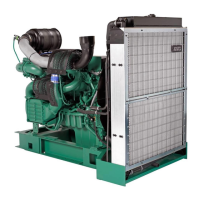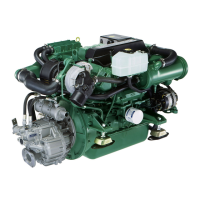
Do you have a question about the Volvo Penta TWD1643GE Series and is the answer not in the manual?
| Engine Model | TWD1643GE |
|---|---|
| Number of Cylinders | 6 |
| Compression Ratio | 17.5:1 |
| Fuel System | Common Rail |
| Governing | Electronic |
| Displacement | 16.1 liters |
| Bore | 144 mm |
| Stroke | 165 mm |
| Aspiration | Turbocharged |
| Engine Speed at Max Power | 2, 300 rpm |
| Engine Speed at Max Torque | 1300 rpm |
| Cooling System | Freshwater cooled |
| Starting System | Electric |
| Emissions Compliance | EPA Tier 3 |
Safety measures for protecting eyes and skin from hazards.
Warnings and precautions related to fire and explosion risks.
Guidelines for safe handling of fuels, oils, and chemicals.
Essential safety rules for starting and running the engine.
Warnings about hazards from hot engine parts and rotating components.
Prohibition of using start spray due to explosion risk.
Safety procedures for detecting leaks in the fuel system.
Precautions for safe handling, charging, and connecting batteries.
Safety guidelines for cleaning engine components and adjustments.
Explains the content and purpose of the Operator's Manual.
Details the limited warranty coverage for the engine.
Guidance on initial engine break-in and recommended fluids.
Importance of maintenance, using genuine parts, and avoiding strain.
Volvo Penta's commitment to environmental care and emission reduction.
Special demands for emission-certified engines regarding care and maintenance.
Information on authorized dealers and action service for support.
Lists the industrial diesel engine models covered by the manual.
Describes the electronic system for diesel engine control.
Introduction to the DCU digital instrument panel and its functions.
Navigating DCU menus and viewing engine data.
Details on Preheat, Governor mode, Diagnostics, and Trip data reset.
Setting up application, units, language, and parameters.
Describes the DCU II display, menus, and alarm messages.
Managing configurations, saving settings, and dealer-specific options.
Explanation of the CIU as an interface between EMS and control panel.
Essential checks to perform before starting the engine.
Step-by-step guide for starting the engine, with and without pre-heating.
Preparations and procedures for starting in very cold temperatures.
Warnings against start spray and instructions for using auxiliary batteries.
How to check instruments and respond to alarms during operation.
Advice on proper maneuvering and avoiding prolonged low load operation.
Steps to take before shutting down the engine to ensure proper cooling.
Information on the auxiliary stop mechanism.
Checks and actions required after the engine has been shut down.
Purpose and function of the engine diagnostic system.
How DCU and DU units display and report engine faults.
Reading fault codes via CIU and Easy Link instruments.
Procedures for resetting and erasing fault codes from memory.
Table of symptoms and possible causes for engine malfunctions.
Recommended service intervals based on operating hours or time.
Conditions for extending engine oil change intervals.
Identification of key engine components for maintenance.
Visual inspection guidelines for the engine and compartment.
Procedure for checking and replacing the engine air filter.
Inspection of charge air hoses and drive belts for damage.
Step-by-step guide for changing the drive belt.
Step-by-step guide for replacing the alternator belt.
Procedure for checking and maintaining the engine oil level.
Steps for draining and refilling the engine oil.
Procedure for replacing the engine oil filters.
How to drain accumulated condensate from the fuel system.
Procedure for replacing the engine fuel filter.
Steps for changing the fuel pre-filter and water trap.
Procedure for bleeding air from the fuel system.
Guidelines for mixing and ensuring the quality of engine coolant.
How to check and refill the coolant level in the system.
Steps for safely draining the engine coolant.
Instructions for cleaning the charge air cooler without high pressure.
Procedure for flushing and cleaning the engine cooling system.
Installation, removal, and cleaning of the cooling air filter.
Specifications for water quality used in the cooling system.
Information on the main switch, fuses, and circuit breaker.
Guidelines for checking and tightening electrical connections.
Tips for increasing battery service life and avoiding accidents.
Step-by-step guide for disconnecting and connecting batteries.
Steps for preparing the engine for storage up to 8 months.
Conservation procedures for lubrication and fuel systems for long periods.
Detailed technical data for various engine models.
Information on oil change volumes, pressure, and recommendations.
Fuel system requirements, restrictions, and properties.
Data on cooling system pressure, volume, and thermostat.
Electrical system voltage, alternator, battery capacity, and platform.











